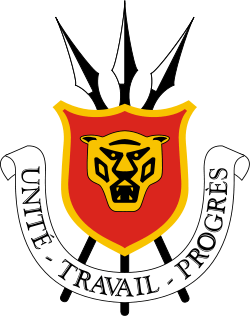Politics of Burundi
 |
| This article is part of a series on the politics and government of Burundi |
|
|
Politics portal |
Politics of Burundi takes place in a framework of a transitional presidential representative democratic republic, whereby the President of Burundi is both head of state and head of government, and of a multi-party system. Executive power is exercised by the government. Legislative power is vested in both the government and the two chambers of parliament, the Senate and the National Assembly.
Political landscape after the civil war
The political landscape of Burundi has been dominated in recent years by the civil war and a long peace process and move to democracy. The current President of Burundi is Pierre Nkurunziza, a former rebel leader of the Hutu National Council for the Defense of Democracy-Forces for the Defense of Democracy who was elected unopposed as the new President of Burundi by the parliament on 19 August 2005. Nkurunziza was the first president chosen through democratic means since the start of the civil war in 1993 and was sworn in on 26 August, replacing transitional president Domitien Ndayizeye.
In November 1995, the presidents of Burundi, Rwanda, Uganda, and Zaire (currently Democratic Republic of Congo) announced a regional initiative for a negotiated peace in Burundi facilitated by former Tanzanian President Julius Nyerere. In July 1996, former Burundian President Buyoya returned to power in a bloodless coup. He declared himself president of a transitional republic, even as he suspended the National Assembly, banned opposition groups, and imposed a nationwide curfew. Widespread condemnation of the coup ensued, and regional countries imposed economic sanctions pending a return to a constitutional government. Buyoya agreed in 1996 to liberalize political parties. Nonetheless, fighting between the army and Hutu militias continued. In June 1998, Buyoya promulgated a transitional constitution and announced a partnership between the government and the opposition-led National Assembly. After facilitator Julius Nyerere's death in October 1999, the regional leaders appointed Nelson Mandela as Facilitator of the Arusha peace process. Under Mandela the peace process has revived and important progress has taken place.
Executive branch
| Office | Name | Party | Since |
|---|---|---|---|
| President | Pierre Nkurunziza | CNDD-FDD | 26 August 2005 |
| Vice-presidents | Thérence Sinunguruza | UPRONA | 29 August 2010 |
| Gervais Rufyiri | 29 August 2010 |
The president is elected by the people. He nominates two vice-presidents, who form together with the Council of Ministers the executive branch.
Legislative branch
The National Assembly (Assemblée nationale) has 118 members, elected for a five-year term by proportional representation with a 2% barrier. The Senate (Sénat) has 49 members, elected for a five-year term by electoral colleges of communal councilors. Extra seats in both chambers can be added to ensure that ethnic and gender quotas are met. Burundi has a multi-party system, with two or three strong parties and a third party that is electorally successful. Parties are usually based on ethnic background.
Political parties and elections
| Parties | Votes | % | Elected seats |
Coopted seats |
Total seats |
|---|---|---|---|---|---|
| National Council for the Defense of Democracy-Forces for the Defense of Democracy (Conseil National Pour la Défense de la Démocratie–Forces pour la Défense de la Démocratie, CNDD-FDD) | 1,417,800 | 58.55 | 59 | 5 | 64 |
| Front for Democracy in Burundi (Front pour la Démocratie au Burundi, FRODEBU) | 525,336 | 21.70 | 25 | 5 | 30 |
| Union for National Progress (Union pour le Progrès national, UPRONA) | 174,575 | 7.21 | 10 | 5 | 15 |
| National Council for the Defense of Democracy (Conseil National Pour la Défense de la Démocratie, CNDD) | 100,366 | 4.14 | 4 | - | 4 |
| Movement for the Rehabilitation of Citizens-Rurenzangemero (Mouvement pour la Réhabilitation du Citoyen-Rurenzangemero, MRC) | 51,730 | 2.14 | 2 | - | 2 |
| Party for National Recovery (Parti pour le redressement national, PARENA) | 42,223 | 1.74 | - | - | - |
| Others & Independents | 109,396 | 4.51 | - | - | - |
| Ethnic Twa Members | - | - | - | 3 | 3 |
| Total (Voter Turnout: 77.2%) | 2,421,426 | 100.0 | 100 | 18 | 118 |
| Invalid/Blank Votes | 24,575 | ||||
| Total Votes | 2,446,001 | ||||
| Registered Voters | 3,167,124 | ||||
| Source: African Elections Database | |||||
| Parties | Elected Members | Co-opted & Other Members |
Total Seats |
|---|---|---|---|
| National Council for the Defense of Democracy-Forces for the Defense of Democracy (Conseil National Pour la Défense de la Démocratie–Forces pour la Défense de la Démocratie, CNDD-FDD) | 30 | 2 | 32 |
| Front for Democracy in Burundi (Front pour la Démocratie au Burundi, FRODEBU) | 3 | 2 | 5 |
| National Council for the Defense of Democracy (Conseil National Pour la Défense de la Démocratie, CNDD) | 1 | 2 | 3 |
| Union for National Progress (Union pour le Progrès national, UPRONA) | - | 2 | 2 |
| Ethnic Twa Members | - | 3 | 3 |
| Ex-Presidents (FRODEBU-2, UPRONA-1 and PARENA-1) | - | 4 | 4 |
| Total | 34 | 15 | 49 |
Administrative divisions
Burundi has 17 provinces: Bubanza, Bujumbura Mairie, Bujumbura Rural, Bururi, Cankuzo, Cibitoke, Gitega, Karuzi, Kayanza, Kirundo, Makamba, Muramvya, Muyinga, Mwaro, Ngozi, Rutana and Ruyigi.
International relations
Burundi is member of ACCT, ACP, AfDB, CCC, CEEAC, CEPGL, ECA, FAO, G-77, IBRD, ICAO, ICRM, IDA, IFAD, IFC, IFRCS, ILO, IMF, Intelsat (nonsignatory user), Interpol, IOC, ITU, NAM, OAU, OPCW, UN, UNCTAD, UNESCO, UNIDO, UPU, WHO, WIPO, WMO, WToO, WTrO.
External links
- Global Integrity Report: Burundi reports on Burundi's anti-corruption efforts.
| ||||||||||||||
| ||||||||||||||||||||||||||||||||||